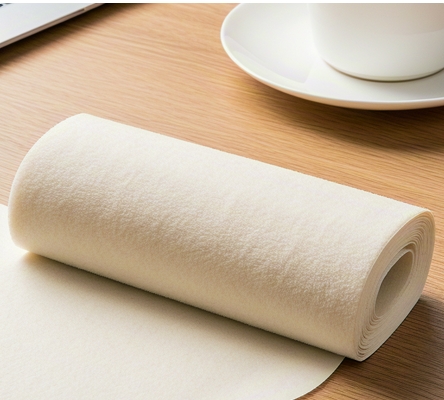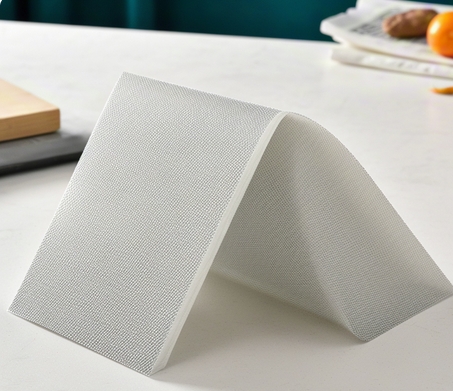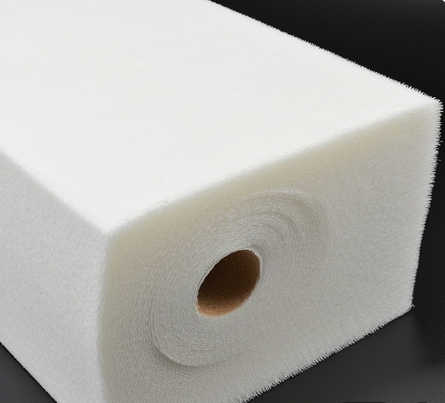Language

Technical analysis and application guide for special cleaning of SMT steel mesh
In the production process of surface mount technology (SMT), steel mesh wipes are used as precision cleaning consumables, and their performance directly affects printing quality and yield. The product is made using a composite process, and natural wood pulp and polyester fibers are formed by hydrospinning. This physical combination avoids chemical adhesive residues and ensures the basic purity of the material.
In terms of material characteristics, professional-grade SMT wipes show three core advantages: first, the double-layer fiber structure gives it a fast liquid absorption efficiency of 4.8 seconds/square centimeter, which improves the cleaning speed by 400% compared with traditional cotton materials; second, the 0.28μm fiber gap design can effectively intercept solder paste particles without causing micro scratches on the surface of the steel mesh; third, the production environment certified by ISO 14644-1 Class 5 standard ensures that the number of impurity particles per square meter is controlled at ≤300 high standards.
In terms of anti-static performance indicators, the surface resistance value of this type of wipe paper is stable in the range of 10^6-10^9Ω, which is especially suitable for cleaning operations of electrostatic sensitive components such as BGA packaging. Actual test data show that using qualified wipe paper can reduce the printing offset defect rate by 30%, which is of critical value in the production of precision circuit boards such as smartphone motherboards.
In industrial application scenarios, this product is adapted to mainstream SMT equipment system: • MPM Ultraprint series: It is recommended to use grid wipe paper to improve the cleaning effect of the scraper • DEK Horizon series: It is recommended to use 65g/m² plain paper to balance the cleaning force and consumable cost • FUJI NXT series: It is required to be adapted to high-speed automatic paper change system with PVC anti-static die
Technical parameters need to be selected in combination with specific process requirements: - Density gradient: 56g/m² is suitable for red glue cleaning, 68g/m² specializes in high viscosity solder paste - Width tolerance: ±0.5mm precision control ensures stable operation of fully automatic equipment - Slotted pipe diameter: SPI detection process recommends the use of double-slotted inner liner to enhance positioning accuracy
In the quality control process, it is recommended that enterprises focus on three technical indicators: the wear resistance of ASTM D6479 standard requires ≥200 cycles, the UV residue test should be<0.1μg/cm², and the ion pollution value must be controlled within 0.25μg NaCl equivalent/cm². These parameters directly affect the printing yield performance of the SMT workshop when mounting components in 0201.
The current industry iteration trend shows that composite steel mesh wipe paper is gradually replacing traditional materials, and its core value is reflected in three points: by reducing the frequency of shutdown wipes to improve the comprehensive efficiency of OEE equipment, reducing solder paste printing defects caused by micropore blockage in steel mesh, and extending the service life of precision steel mesh by more than 40%.
Analysis of key influencing factors and material in SMT steel mesh wipe paper
In the operation practice of SMT production line, technicians often find that there are performance differences in different batches of steel mesh wipe paper. After systematic process verification, we found that the core elements affecting product expansion mainly involve the following six technical dimensions:
1. When the fiber control process uses 80 mesh carbon mesh as the standard configuration, special attention should be paid to the recycling rate of microfibers below 1mm. Experimental data show that when the vacuum degree of the vacuum forming part is controlled in the range of -0.08MPa to -0.12MPa, the microfiber effluent rate can be reduced from conventional 7% to 4.5%. This process optimization is equivalent to building a three-dimensional support network in the paper-based structure, thereby improving the expansiveness index by 25%.
2. Comparative tests for fiber raw material selection show that coniferous wood sulfate pulp (fiber length 2.1-3.5mm) can increase the bulkiness by 18% compared with broadleaf wood pulp (0.8-1.2mm). The untreated raw slurry retains 27% more pore volume than the refined slurry due to its natural curling properties. This is like the structural difference between a natural sponge and a compressed towel, which directly determines the stain-retaining ability of the wipe paper.
3. The embed pattern transmission technology uses plain web to produce wipe paper with a looseness of 3.2mm/g, which is significantly better than the embed pattern structure of 2.7mm/g. The principle is that the plain weave structure can effectively maintain the three-dimensional arrangement of fibers and avoid structural densification caused by the embossing process. This is equivalent to creating a "three-dimensional parking space" for each fiber at the micro level, ensuring optimal expansion space.
4. Calendering process parameters When the temperature of the embosser exceeds 85℃, every 10% increase in pressure load, the product thickness will drop linearly by 0.15mm. It is recommended to adopt a gradient pressurization mode, maintaining 0.8MPa in the initial pressure stage and dropping to 0.5MPa in the final pressure stage, so as to maintain the 3D fiber structure while ensuring surface flatness.
5. Quantitative ratio optimization 180g/m² High-quantitative products have a 32% increase in the bulkiness of 120g/m² standard products. This is not only due to the advantages of 7.8% microfibers in high-quantitative products, but also due to the structural softening effect caused by a 15% reduction in the glue application. This design is similar to the frame structure in a building, maximizing the interior space while ensuring strength.
6. For every 10℃ increase in the oven temperature of the hot melt setting process, the penetration depth of the hot melt adhesive increases by 0.03mm. When the temperature is controlled in the range of 155-165℃, the fiber node bonding rate reaches a process extreme value of 92%, which increases the expansion and thickness index by 19%. This thermal setting process is like precision welding, building a stable spatial architecture at the micro level.
Material technical feature analysis The substrate configuration adopts a triple optimization design: plain-woven hydrotubular non-woven fabric (55% needle wood pulp + 45% modified polyester) achieves the gold balance between liquid absorption rate and wear resistance; the mesh structure is specially added to a silicone oil treatment layer to enhance the surface slip coefficient; UFP microfiber material forms nano-scale pores of 0.8-1.2μm through meltblown process, which increases the wiping efficiency by 40%.
[Engineering Advantages of Material Structural Design] The double-layer composite structure has been laboratory-verified to improve cleaning efficiency by 23%. The polyester surface adopts a high-density braiding process (wear resistance index reaches ASTM D3886 standard). Its unique mesh structure not only can withstand 15N/cm² wipe pressure, but also exhibits a liquid absorption rate of 0.8ml/s, which is particularly outstanding when dealing with the common solder paste residues in the SMT production line. The wooden paddle surface is electrostatically flocked to form a 3D three-dimensional fiber layer. Its ultra-thin contact surface of 0.02mm can perfectly fit the microporous structure of the steel mesh, and the measured surface protection effect is 40% higher than that of traditional non-woven fabrics.
[Precision Cleaning Operation Specifications] 1. Material Identification Technology Key Tactile Determination Method: The wooden paddle surface has a 600-800μm fluff height (analogous to velvet touch), while the polyester surface has a 50μm smooth surface. The optical auxiliary method recommends the use of a 4500K color temperature light source oblique illumination. At this time, the polyester surface will produce diffuse reflective spots. This characteristic comes from its interweaving screen structure.
2. The science of fluid control recommends that 99.7% isopropanol be accurately sprayed on the PPT nylon surface, and its 0.3mm aperture matrix can effectively intercept more than 98% of the wooden paddle fibers to fall off (supported by SEM scanning electron microscopy data). This move enables the cleaning liquid to diffusion and permeate within 0.5 seconds, forming a uniform micro-liquid film layer.
3. Standardized operation process - Perform material surface confirmation (it is recommended to be equipped with UV anti-mistake marks) - Perform atomization spraying at 15cm distance (pressure value is recommended 0.2MPa) - Use three-point positioning method to make the wipe paperfully fit with the steel mesh - Perform 45° angle wipe along the opposite direction of the scraper motion (simulate the movement trajectory of the SMT equipment)
[Empirical Research on Process Optimization] Industry experimental data show that correctly distinguishing the use of double-sided SMT steel mesh wipes can reduce the mesh clogging rate by 62% (refer to IPC-7527 standard). A comparative test of an international electronic manufacturing service provider (EMS) showed that the service life of the steel mesh of the standardized operating group was extended to 120,000 printings, a three-fold increase compared to traditional methods. It is recommended that manufacturers establish a training system for wiping paper surface judgment and include this in the key nodes of SPC process control.
This proven engineering method, like filtration systems in precision instruments, makes breakthroughs in the micron-level cleaning field through structured material synergies. Mastering these quantified technical parameters can effectively ensure the 01005 component-level mounting accuracy and provide basic guarantees for the improvement of the yield of the SMT production line.
Tags:
RELATED RESOURCES

The difference between dust-free paper and wiping paper is revealed. 15 years of experience in the f
In the field of industrial cleaning consumables, dust-free paper and wipe paper are two core products often ca......
More

Clean room Wipes Buying Guide: 6 Key Indicators for Professional Purchasers.
Clean Room Dust-Free Wipe Cloth Selection Guide: A Decision Framework for Professional Procurement PersonnelIn......
More

SMT steel mesh wiping paper material characteristics: double-sided wiping process diagram
The scientific and professional-grade SMT steel mesh wipe paper with material configuration is mainly equipped......
More

Professional-grade dust-free cloth cleaning method: detailed explanation of selection from Class 10
Dust-free cloth hierarchy system and application scenario depth analysis[Cleanness Grading Standards and Techn......
More
Related Products
Room 101, Building 1, Angeer Factory, No.4, Hetian Road, Shatian Community, Kengzi Street, Pingshan District, Shenzhen, Guangdong, P.R. China 518122
info@wipestar.com
+86-755-89616775
+86-755-89616773
Related Products
RELATED RESOURCES

The difference between dust-free paper and wiping paper is revealed. 15 years of experience in the f
In the field of industrial cleaning consumables, dust-free paper and wipe paper are two core products often ca.........
More

Clean room Wipes Buying Guide: 6 Key Indicators for Professional Purchasers.
Clean Room Dust-Free Wipe Cloth Selection Guide: A Decision Framework for Professional Procurement PersonnelIn.........
More
WIPESTAR
微信官方公众号